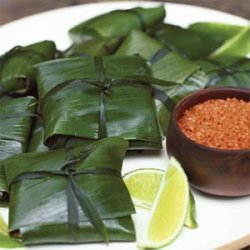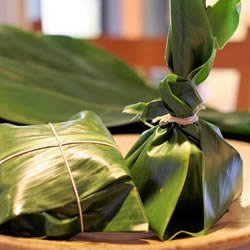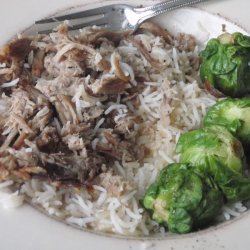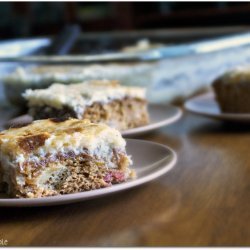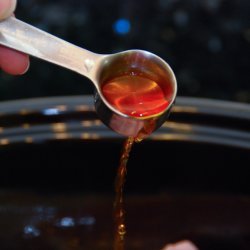Ingredients:
- shovels, as needed
- 15 cubic feet lava river rocks (lava rocks are porous) to be pre-heated
- 1/2 cord wood
- 6 to 8 sheet metal panels measuring approximately 4 feet square (these will retain the heat without being consumed by the fire)
- metal fire tongs to move rocks, panels, wood
- fire mitts to protect your hands from the heat
- safety goggles and protective gear for your body
- a large bunch of ti leaves bound together to be used as a brush to remove ash from the rocks
- a stretcher constructed with 2 (8-foot long, 2 by 6-inch pieces) lumber to comprise the wood handles, connected by 2 (2 by 6 cross) pieces each 3 to 4-feet in length, and an affixed support platform made of 3/4-inch plywood which is 4 feet long by 3 to 4 feet wide
- 15 feet of 4 foot high heavy gauge chicken wire temporarily affixed to the platform part of the stretcher to hold the pig closed after adding the rocks to the carcass
- 14 gauge wire as needed to secure the chicken wire
- wire cutters
- 1 entire head-on pig carcass, innards removed
- banana stumps to place between the pig meat and the hot coals to prevent the flesh from burning
- another large bunch of ti leaves , hard stalks snapped out , to be used like aluminum foil to steam the pig
Directions:
- Dig a pit in the sand 2 feet deep and 6 feet in diameter. Add the river rocks and cover with enough of the wood to get the fire underway to heat the rocks. (You will add the additional wood as needed.) Start the fire (to heat the rocks to 800 degrees F). Add the metal panels on top of the fire to contain heat without smothering the fire.
- Using assistance place the gutted pig in the supine position on the stretcher-like platform and wrap the affixed chicken wire around to mostly secure the pig, but leaving enough room to be able to put the heated lava rocks inside the body cavity.
- Place some banana stumps in the body cavity of the pig to serve as a buffer between the hot coals and the pig meat to prevent the flesh from burning.
- Protecting your face, hands, and body with proper gear and using safe equipment, remove enough of the metal panels from the fire to retrieve the heated rocks with fire safe tongs. Someone will use heavy fire mitts to hold the rocks in a pair of tongs, while the other person uses the ti leaves brush to dust off the ash. The rocks with the ash removed are then placed one-by-one in the cavity of the pig so it will cook from the inside out with dry heat. Place some additional banana stumps in the body cavity of the pig to serve as a buffer between the hot coals and the pig meat to prevent the flesh from burning. The carcass of the pig is then closed with chicken wire and additional metal wire as needed to secure the chicken wire. Remove the attachments that have been holding the chicken wire to the stretcher. Transfer the pig to sit atop the metal panels of the imu, and use the additional ti leaves like aluminum foil, placing them dull side up, shiny side down in a cross configuration to steam the exterior of the pig with the moisture from the ti leaves.
- When the pig is cooked through, approximately eight hours, use assistance to remove it from the fire, let rest for 30 minutes, then carve it down. The cheeks of the pig should be reserved for the most honored guest.
Nutrition Facts
| Amount Per 1 Serving | |||
| Calories | 0.17 Kcal (1 kJ) | ||
| Calories from fat | 0.04 Kcal | ||
| % Daily Value* | |||
| Total Fat | 0g | 0% | |
|---|---|---|---|
| Sodium | 0.01mg | 0% | |
| Potassium | 2.59mg | 0% | |
| Total Carbs | 0.03g | 0% | |
| Sugars | 0.01g | 0% | |
| Dietary Fiber | 0.02g | 0% | |
| Protein | 0.02g | 0% | |
| Vitamin C | 0.2mg | 0% | |
| Calcium | 0.4mg | 0% | |
| Amount Per 100 g | |||
| Calories | 42 Kcal (176 kJ) | ||
| Calories from fat | 9 Kcal | ||
| % Daily Value* | |||
| Total Fat | 1g | 0% | |
|---|---|---|---|
| Sodium | 3mg | 0% | |
| Potassium | 648mg | 0% | |
| Total Carbs | 7g | 0% | |
| Sugars | 3g | 0% | |
| Dietary Fiber | 4g | 0% | |
| Protein | 5g | 0% | |
| Vitamin C | 52mg | 0% | |
| Iron | 2mg | 0% | |
| Calcium | 107mg | 0% | |
* Percent Daily Values are based on a 2000 calorie diet. Your daily values may be higher or lower depending on your calorie needs.
Find out how many calories should you eat.
Get Your Recipe of Health!
Follow RecipeOfHealth on Facebook!


